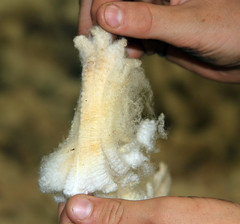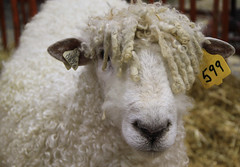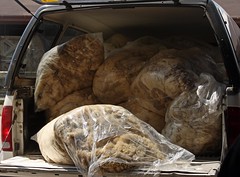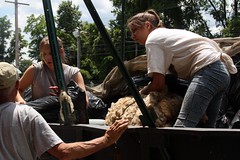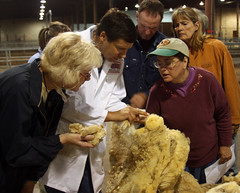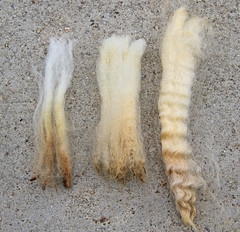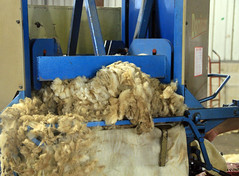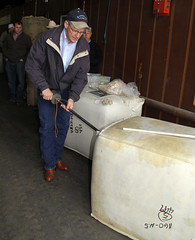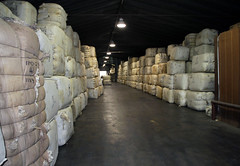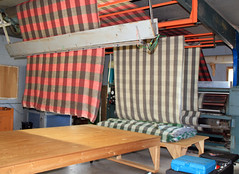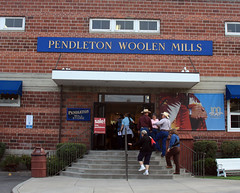- Sheep 201 Index
- Other web sites

Wool clothing
Wool Marketing
Most sheep grow wool that needs to be harvested at least annually. It is not uncommon to shear some of the longer-wooled breeds twice a year. Although some breeds have more valuable wool than others, all wool has value and should be prepared properly to maximize its return.
In some sheep operations, wool comprises a significant portion of the income to the enterprise. In other operations, it may be a by-product of lamb or dairy production or even a cost of production. Hair sheep do not produce salable fiber.
Wool was the first commodity to be traded internationally. It figures prominently in the history of the United States and many other countries, especially the United Kingdom. It is still important to the agricultural economies of many counties and countries.
Value-determining characteristics of wool
Many factors determine the quality (and value) of wool. These include fiber diameter, crimp, yield, color, purity, and staple length and strength.
Fiber diameter, also called fineness, is the actual measurement of the thickness of the wool fiber. It is measured in microns (μm), which is one millionth of a meter. The diameter of the fiber determines the thickness of the yarns that can be made of it. Smaller diameter wools (22 microns or less) can be made into finer yarn.
Uniformity of fiber diameter is also very important. While different parts of the sheep's fleece may have different fiber diameters, too much variation in fineness (grade) is undesirable. Average fiber diameter is the single most important value-determining characteristic of wool. Fiber diameter is estimated visually or may be determined in a laboratory by objective measurement.
Crimp is the natural waviness or bend of the wool fiber. It varies with the diameter of the fiber and can be used as a predictor of fineness. Fine wools have more crimp per unit of length than coarser wools. Hair has no crimp.
Yield is the amount of wool left after scouring (washing). It is usually expressed as a percentage of the original "grease" fleece weight. "Shrinkage" in wool is comprised of wool grease (lanolin), sand, dirt, dust, and vegetable matter (VM). Yield in wool is quite variable (e.g. 40 to 70 percent) and it is affected by many factors, both genetic and environmental. Bulkiness of fleece generally indicates a high yield.
In the commodity market, wool that has dark fibers is very undesirable. This is because colored fibers cannot accept dye. In contrast, in many niche markets, colored fibers are very desirable, as many hand spinners and weavers prefer natural colors.Staple length is measured from the base to the tip of the unstretched fiber. Longer-stapled wools are more valuable. Length also adds more weight to the fleece than any other single characteristic. Strength is another important aspect of staple length. Strength determines wool's ability to withstand vigorous cleaning and manufacturing. Tender wool or wool with breaks in the fiber greatly diminish the value of the fleece.
Marketing options for wool
The world wool market is dominated by Australia, while China is the world's largest producer and consumer of wool. New Zealand is another large producer. The United States is a minor player in the world wool industry and is a net importer of wool. In the world wool market, super fine wools are the most valuable. They are made into the highest quality clothing, usually high fashion items.Wool marketing can be broadly classified into two methods: commodity and direct (or niche).
Commodity
Wool pools
Most sheep producers don't have enough of their own wool to market it directly to a warehouse or woolen mill. Many county, regions, or states operate wool pools. A wool pool is a group of producers who combine their wool for marketing. There is enough wool at a pool so that it can be separated (classed) and sold according to type and quality. In recent years as market conditions have changed and the wool industry has continued to contract, many wool pools have been consolidated to create more sizable lots. Some wool pools have ceased to operate.
Private or cooperative wool warehouse
Wool warehouses act as "brokers" for wool. The largest wool warehouse in the United States is Roswell Wool (in New Mexico). Their wool is offered for sealed bids to consignments via regularly schedule sales. Mid-States Wool Growers Cooperative Association (in Ohio) operates the oldest wool warehouse in the United States. Mid-States offers various marketing options to producers: cash, grade and yield, consignment, consignment premiums, and clean price core test grade and yield.Fiber co-ops
Fiber co-ops are sometimes formed to try to add value to producers' wool. Some cooperatives are large and have formed alliances with international partners. Others are small. Producers' Marketing Cooperative, Inc. (PMCI) is a grower-owned cooperative headquartered in Mertzon, Texas. They market approximately 1.5 million pounds of product annually.
Direct marketing of wool
Direct marketing is when the product is marketed directly to the end consumer. The most common method of direct marketing wool is marketing whole fleeces directly to handspinners, weavers, and other wool craftsmen.Different types of wool have different characteristics and uses. Handspinners have different preferences the type and color of wool that they spin. Long wools are popular among handspinners, as they are the easiest to spin. Some handspinners will combine different types of wool or animal fibers.
Regardless of the type of wool preferred, all handspinners desire clean wool that is free from vegetable matter and other contaminants. Fleeces marketed to handspinners should be skirted. Many times, the sheep are covered to keep their fleeces clean and minimize the effects of weathering. The cost of covering is more than offset by the higher prices received for the fleeces.
There are various ways to add value to wool. Wool roving is a piece of wool that has been washed and combed into a clump and twisted to hold the fibers together. Flattened roving is known as batting. Rovings are used for spinning, felting, stuffing, padding, and various craft projects. Wool can be processed one step further and made into yarn.
Various finished products, made from wool, can be marketed directly to consumers or other outlets: garments, outerwear, rugs, bedding, etc. For producers with lower quality wool (e.g. meat-type), making wool into blankets provides an excellent means to add value and direct market product.
Wool Loan and LDP program
In the United States, marketing assistance loans and loan deficiency payments (LDPs) are available to wool growers. Eligible producers may request a 9-month marketing assistance loan or request an LDP.
An LDP is a payment from the government. It is the difference between the loan rate and repayment rate. The loan rate stays the same for several years and is different for ungraded vs. graded wool. The repayment rate fluctuates. LDPs are available for both shorn wool and unshorn lambs. The payment for unshorn lambs is 6.865 lbs. x the LDP rate.
Commodity Graded wool Ungraded wool Unshorn lamb Source: USDA FSA, 8.31.2020
In a marketing assistance loan, wool is used as collateral for a loan from USDA. The wool program is managed by local FSA (Farm Service Agency) offices. Marketing loans and LDPs should be applied for before beneficial interest in the wool is lost.
Producing quality wool
A quality wool clip starts long before shearing. Wool production is a year-round process. Proper harvesting techniques are important.
Producers should make an effort to prevent contamination of fleeces. Feeders which keep hay and chaff off the backs of sheep should be used. Hay should not be carried or thrown over the sheep. Grain should not be poured over their heads. Sawdust or shavings should not be used as the sole type of bedding. Burr-producing plants should be removed from pastures. Animals with high quality wool can be protected with coats.
Only approved, soluble products should be used for paint branding and marking. Poly contamination is the number one problem with American wool. Sources of poly contamination are poly tarps, poly feed bags, and poly twine. Producers should take steps to avoid poly contamination.
Shearing
Sheep should be sheared as early in the spring as possible. If possible, they should be crutched or sheared prior to lambing. Sheep should be sheared on a clean, dry surface. Plywood, old rugs or canvas, or concrete floors are all suitable shearing surfaces. The shearing floor should be swept after each sheep. The belly wool, top knot, and other tags should be packaged separately from the fleece wool.Skirting
High quality fleeces for both commodity and niche markets should be skirted. Skirting is when the undesirable parts of the fleece are removed: tags, stained wool, sweat locks, second cuttings, and any other undesirable material. A simple skirting table can be made from a 4 x 6 foot wooden frame to which a section of 1 x 2 inch wire mesh (48 inches high) is attached.
Packaging
Wool should be packed loose in regulation wool bags. It should not be packaged in plastic grain sacks. If wool is packaged in plastic trash bags, the tags should be left open to allow moisture out. If fleeces are tied, only paper twine should be used.
Download the U.S. Certified Choice Wool Clip Grower Declaration and Checklist
Classing wool
Classing is grouping like wool with like wool. It is similar to grading. Classing can be done at the farm. It is done at wool pools and warehouses.
Source: Preparation steps for wool quality improvement (ASI)
Wool breeds American Cormo, Booroola Merino, Debouillet, Delaine Merino, Rambouillet Dual or general
purposes breedsColumbia, Panama, Corriedale, Targhee, Finn cross, Polypay Meat breeds:
white faceCheviot, Dorset, Finnsheep, Gulf Coast Native, Montadale, North Country Cheviot, Texel Meat breeds:
non-white faceClun Forest, Hampshire, Oxford, Southdown, Tunis, Shropshire, Suffolk Long wool
and carpet breedsBlueface Leicester, Border Leicester, Coopworth, Cotswold, Lincoln, Perendale, Romney Double-coated or hair sheep crosses Barbados Blackbelly, California Red, Icelandic, Karakul, Katahdin, Navajo Churro, Romanov, St. Croix Various
<== SHEEP 201 INDEX
Copyright© 2021. Sheep 101 and 201.

